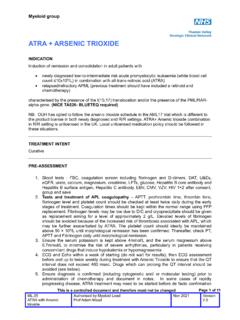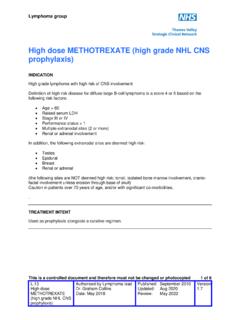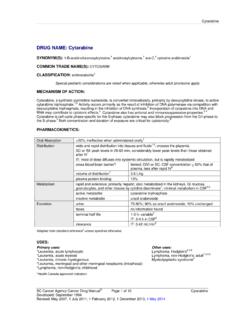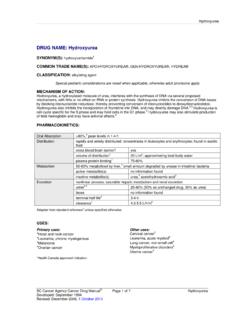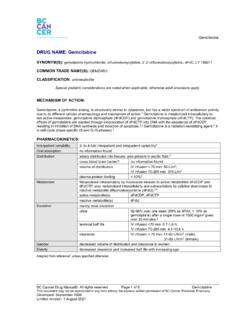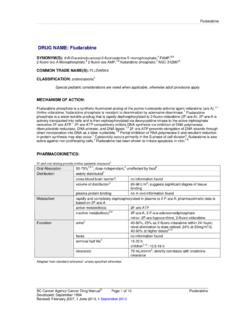Transcription of NSSG Chemotherapy Protocol
1 Myeloid group This is a controlled document and therefore must not be changed FLAG- IDA Authorised by Myeloid Lead Prof Adam Mead Oct 2019 Version Page 1 of 4 FLAG -IDA INDICATION Induction Chemotherapy for patients with acute myeloid leukaemia (AML) or in relapse/ refractory disease (AML or ALL). For patients under 60 years of age but it can be applied to older patients according to clinician's assessment. TREATMENT INTENT Curative PRE-ASSESSMENT 1. Ensure diagnosis is confirmed with appropriate tests and is documented in notes.
2 2. Blood tests - FBC, DCT, U&Es, LDH, ESR, urate, calcium, magnesium, creatinine, LFTs, glucose, Igs, 2 microglobulin, hepatitis B core antibody and hepatitis B surface antigen, hepatitis C antibody, EBV, CMV, VZV, HIV 1+2 after consent, group and save. 3. Pregnancy Test - for all women with childbearing potential before each new Chemotherapy course. 4. ECG +/- Echo - if clinically indicated. 5. Record performance status (WHO/ECOG). 6. Record height and weight. 7. Consent - ensure patient has received adequate verbal and written information regarding their disease, treatment and potential side effects.
3 Document in medical notes all information that has been given. Obtain written consent prior to treatment. 8. Fertility - it is very important the patient understands the potential risk of infertility, all patients should be offered fertility advice (see fertility guidelines). 9. Send a "group and save" sample to transfusion and inform patient and transfusion laboratory that they will require irradiated blood products for all future transfusions. Ensure irradiation card is attached to the patient's notes. See Guidelines for the use of blood components in adult haematology.
4 10. Hydration and tumour lysis prevention in patients with bulk disease (refer to tumour lysis Protocol ) 11. Consider dental assessment / Advise dental check is carried out by patient's own dental practitioner before treatment starts in practical. 12. Treatment should be agreed in the relevant MDT. 13. Central venous access should be used, Hickman line or PICC. In urgent cases it may be necessary to start Chemotherapy via a peripheral cannula. Myeloid group This is a controlled document and therefore must not be changed FLAG- IDA Authorised by Myeloid Lead Prof Adam Mead Oct 2019 Version Page 2 of 4 drug REGIMEN Days 1 to 7 G-CSF subcutaneous.
5 As per local policy (up to 28 days). ( Filgrastim ) Days 2 to 6 FLUDARABINE 30 mg/m2 daily in 100 mL sodium chloride intravenous infusion over 30 minutes (5 doses). Fludarabine infusion must precede the administration of cytarabine by 4 hours. Days 2 to 6 cytarabine * 2 g/m2 daily in 250 mL sodium chloride intravenous infusion over 4 hours (5 doses). Days 4, 5 and 6 IDARUBICIN 8 mg/m2 intravenous bolus daily (3 doses). NB: *For patients aged 60 years and over the cytarabine dose should be halved to 1g/m2 daily (total 5g/m2 over 5 days).
6 Course 2 can be considered upon count recovery (general guidance: neutrophils >1 x109/L and platelets >100 x109/L). Idarubicin use and dosage must be carefully considered in Course 2 (total lifetime anthracycline dose and high risk of delayed regeneration). Maximum two courses. DOSE MODIFICATIONS Fludarabine Renal impairment Hepatic impairment CrCl > 70 mL/min: give 100% dose CrCl 30-70 mL/min: give 50% dose CrCl < 30 mL/min: omit / contra-indicated No dose changes recommended cytarabine - discuss with consultant Renal impairment Hepatic impairment GFR < 60 mL/min : give 60% dose GFR < 45 mL/min: give 50% dose GFR < 30 mL/min: omit Bilirubin > 34 micromol/L.
7 Give 50% dose Escalate doses in subsequent cycles in the absence of toxicity Idarubicin - discuss with consultant Renal impairment Hepatic impairment Cr < 100 micromol/L give 100% dose Cr 100-175micromol/L: give 50% dose Cr > 175 micromol/L: clinical decision Bilirubin < 40 micromol/L: give 100% dose Bilirubin 40-85micromol/L: give 50% dose Bilirubin > 85 micromol/L - discuss with consultant Maximum cumulative dose: Idarubicin-related cardiomyopathy was reported in 5% of patients who received cumulative intravenous doses of 150 to 290 mg/m2.
8 Myeloid group This is a controlled document and therefore must not be changed FLAG- IDA Authorised by Myeloid Lead Prof Adam Mead Oct 2019 Version Page 3 of 4 INVESTIGATIONS FBC, U&E, LFT, Coagulation screen. Recent bone marrow aspirate - this should be evaluated cytologically before proceeding with Course 2. CONCURRENT MEDICATION drug Dose and duration Allopurinol 300 mg daily for first 14 days of initial induction Chemotherapy . (If a remission is attained, the subsequent use of allopurinol is not required) Fungal prophylaxis As per local Protocol Aciclovir 200 mg three times a day for duration of treatment and for 3 months after completion Proton pump inhibitor As per local formulary Prednisolone eye drops or Dexamethasone eye drops (depending on local formulary) One drop into each eye QDS from Day 2.
9 Continue for 5 days after cytarabine (due to risk of cytarabine -induced conjunctivitis). In the event of conjunctivitis consider increasing the frequency to 2-hourly until resolution of symptoms. Liaison with local ophthalmologists may be necessary in this situation PCP prophylaxis can be considered according to clinical assessment: co-trimoxazole or pentamidine according to local guidelines. EMETIC RISK Day 2-6: High ADVERSE EFFECTS / REGIMEN SPECIFIC COMPLICATIONS Fludarabine Nausea, vomiting, alopecia, CNS side-effects have been rarely described (agitation, confusion, visual disturbance).
10 , cytarabine Nausea, diarrhoea, oral ulceration, hepatic dysfunction. A cytarabine syndrome is also recognised in which patients suffer from fever, myalgia, bone pain, occasional chest pains, maculopapular rash, conjunctivitis and malaise. It usually occurs 6 - 12 hours following administration. Neurotoxicity also reported, cerebellar damage. Idarubicin Myelosuppression. Cardiotoxicity may occur - cumulative dose associated with cardiotoxicity is not known but it is thought that a total dose of 60-80 mg/m2 is not problematic.







